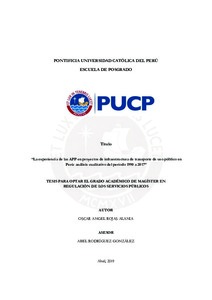| dc.contributor.advisor | Rodríguez González, Abel | |
| dc.contributor.author | Rojas Alania, Oscar Angel | es_ES |
| dc.date.accessioned | 2019-06-05T00:55:20Z | es_ES |
| dc.date.available | 2019-06-05T00:55:20Z | es_ES |
| dc.date.created | 2019-04 | es_ES |
| dc.date.issued | 2019-06-04 | es_ES |
| dc.identifier.uri | http://hdl.handle.net/20.500.12404/14323 | |
| dc.description.abstract | Como consecuencia de los resultados favorables obtenidos a nivel mundial y regional sobre
la participación privada en activos estatales, vía procesos de privatizaciones y concesiones, el
Estado Peruano, a partir de la década de los noventa, hizo uso del mecanismo de la
Asociación Público Privada (APP) para proveer infraestructura de transporte de uso público
(ITUP).
Los resultados obtenidos en Perú en el periodo 1990 a 2017 fueron muy importantes para
dotar de activos estatales relacionado con la infraestructura de transporte de uso público.
De esta forma, mediante las APP se creó nueva infraestructura o se amplió la infraestructura
existente de una forma que, bajo la provisión directa del Estado Peruano, a través de la
contratación pública tradicional (CPT), no era posible de ser realizado. Sin embargo, aún
subsiste una importante brecha de infraestructura de transporte.
Los resultados del desarrollo de las APP para los proyectos ITUP en Perú, han venido de la
mano de la recurrencia de renegociaciones contractuales que se vienen presentando en los
contratos supervisados por el Organismo Supervisor de la Inversión en Infraestructura de
Transporte de Uso Público (Ositran) y materializados en adendas, problema que lleva a
preguntarse si la recurrencia en las renegociaciones contractuales se debe a que el Estado
Peruano ha venido empleando adecuadamente el mecanismo de las APP para ejecutar estos
proyectos.
Para responder esta pregunta, en el presente trabajo realizamos una evaluación cualitativa de
los contratos de ITUP de uso público a cargo de Ositran, para determinar si el mecanismo
de las APP fue el adecuado para los contratos de concesión suscritos. Para ello empleamos
los criterios de elegibilidad de los proyectos de APP, que establece el Estado Peruano, para
calificar los treinta contratos de concesión vigentes, las cuales se ponen en relación con un
indicador de renegociaciones.
Posteriormente, se determina que el Estado Peruano, en el periodo 1990 a 2017, ha venido
empleando adecuadamente el mecanismo de las APP en la provisión de ITUP y, producto
de las relaciones y tendencias que se derivan de las renegociaciones y los resultados de la
evaluación cualitativa, se identifican resultados relevantes.
La investigación culmina presentando un conjunto de conclusiones y recomendaciones. | es_ES |
| dc.description.abstract | As a consequence of the favorable results obtained at a global and regional level on private
participation in state assets, through privatization processes and concessions, the Peruvian
State (Estado Peruano), from the decade of the nineties, made use of the mechanism of the
Public-Private Partnerships (APP) to provide transport infrastructure for public use (ITUP).
The results obtained in Peru in the period 1990 to 2017 were very important to provide state
asset related to public transport infrastructure.
In this way, through the APP, new infrastructure was created or the existing infrastructure
was expanded in a way that, under the direct provision of the Peruvian State, through
traditional public procurement (CPT), it was not possible to be carried out. However, there
is still a significant transport infrastructure gap.
The results of the development of APP for ITUP in Peru have come hand in hand with the
recurrence of contractual renegotiations that have been presented in the contracts supervised
by the Organismo Supervisor de la Inversión en Infraestructura de Transporte de Uso
Público (Ositran) and materialized in addenda, a problem that leads to ask if the recurrence
in contractual renegotiations is due to the fact that the Peruvian State has been adequately
using the APP mechanism to execute these projects.
To answer this question, in this work we conducted a qualitative evaluation of the ITUP
contracts by Ositran, to determine if the mechanism of the APP was adequate for the
concession contracts signed. For this we use the eligibility criteria of the APP projects, which
the Peruvian State establishes, to qualify the thirty current concession contracts, which are
related to a renegotiation indicator.
Subsequently, it is determined that the Peruvian State, in the period 1990 to 2017, has been
adequately using the mechanism of APP in the provision of ITUP, and as a result of the
relationships and trends that result from the renegotiations and the results of the qualitative
evaluation, relevant results are identified.
The research culminates by presenting a set of conclusions and recommendations. | es_ES |
| dc.description.uri | Tesis | es_ES |
| dc.language.iso | spa | es_ES |
| dc.publisher | Pontificia Universidad Católica del Perú | es_ES |
| dc.rights | info:eu-repo/semantics/openAccess | es_ES |
| dc.rights.uri | http://creativecommons.org/licenses/by/2.5/pe/ | * |
| dc.subject | Transporte y Estado--Perú | es_ES |
| dc.subject | Inversiones--Perú | es_ES |
| dc.subject | Empresas privadas--Perú | es_ES |
| dc.subject | Contratos--Perú--Evaluación | es_ES |
| dc.title | La experiencia de las APP en proyectos de infraestructura de transporte de uso público en Perú: análisis cualitativo del período 1990 a 2017 | es_ES |
| dc.type | info:eu-repo/semantics/masterThesis | es_ES |
| thesis.degree.name | Magíster en Regulación de los Servicios Públicos | es_ES |
| thesis.degree.level | Maestría | es_ES |
| thesis.degree.grantor | Pontificia Universidad Católica del Perú. Escuela de Posgrado | es_ES |
| thesis.degree.discipline | Regulación de los Servicios Públicos | es_ES |
| renati.advisor.cext | 000088415 | |
| renati.discipline | 417697 | es_ES |
| renati.level | https://purl.org/pe-repo/renati/level#maestro | es_ES |
| renati.type | http://purl.org/pe-repo/renati/type#tesis | es_ES |
| dc.publisher.country | PE | es_ES |
| dc.subject.ocde | https://purl.org/pe-repo/ocde/ford#5.09.00 | es_ES |






